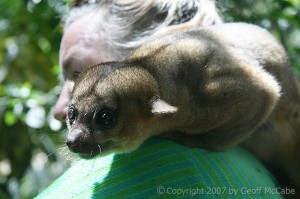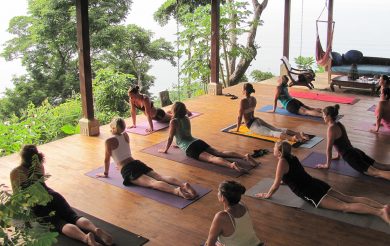- Home
- Accommodation
- Activities
- Area Info
- Maps
- Photo Galleries
- Real Estate
- Travel
Kinkajou
Spanish Name: Martilla, Cuchicuchi
Found In: The kinkajou lives in the elevated canopies of several forests, including mature, disturbed, and secondary rainforests. They can also be spotted deciduous forest, and sometimes gardens and plantations.
Height/Weight: The head and body length is 0.5 m; tail length 0.45 m; they weight about 3 kg.
Life Expectancy: 20- 23 years
 The kinkajou lives in multi stage forest canopies, including mature, disturbed, and secondary rainforests. They may also be spotted in gallery forests, deciduous forests, and sometimes at times smaller plantations. Kinkajous are omnivorous creatures. To help them with their arboreal tendencies, kinkajous have flexible knees and ankles that can rotate 180º, allowing the animals to come down from trees headfirst easily. They also have lengthy tongues, perfect for accumulating nectar. Kinkajous look extremely cute and cuddly like teddy bears and are hence much sought after in the exotic pet market. Their poaching has led to a drastic reduction in their numbers.
The kinkajou lives in multi stage forest canopies, including mature, disturbed, and secondary rainforests. They may also be spotted in gallery forests, deciduous forests, and sometimes at times smaller plantations. Kinkajous are omnivorous creatures. To help them with their arboreal tendencies, kinkajous have flexible knees and ankles that can rotate 180º, allowing the animals to come down from trees headfirst easily. They also have lengthy tongues, perfect for accumulating nectar. Kinkajous look extremely cute and cuddly like teddy bears and are hence much sought after in the exotic pet market. Their poaching has led to a drastic reduction in their numbers.
Owing to their foraging habits, the Kinkajous help plant several plants they feed on by being channels of seed dispersion. With all the fruits and flora they consume, these creatures often swallow whole seeds and transfer them to the ground via the defecation process. Kinkajous are often carriers of the seeds before they deposit them in a faraway spot. Kinkajous will also pollinate flowers by transferring on pollen that gets on their faces when they drink nectar.
Like other species of the procyonid family, kinkajous aren’t very big creatures. They are only about 16 to 22 inches in length, and about 45 inches with the tail. They are often attacked by wild felines such as jaguars, ocelots and margays, but possess a sort of hidden ability that allows them to quickly escape their predators. Kinkajous can dexterously rotate their feet and speedily run backwards. They also have a highly perceptive and evolved sense of hearing that allows them to recognize ensnarling predators like snakes.
The kinkajou has long curved claws that help it live an arboreal life in the elevated forest canopies. It is flexible and muscular, yet short-legged. It possesses a distinct prehensile, tapered tail that the kinkajou keeps quirkily curled most of the time. Kinkajous are very noisy animals. They can be heard shrieking loudly and jumping from one tree to another at night in the Montezuma region. Guests staying at resorts in and around Montezuma can hear kinkajou calls that are more like short noisy barks.
Kinkajous are mainly nocturnal creatures. Their daytime is spent lazily lying on the elevated forest canopies or hollow trees. Though they are members of the carnivorous family, they are equally at home consuming fruits and seeds. The creatures are known to stringently select their fruits, while also feasting on flowers, nectar, nascent leaves, insects, honey and bird eggs. Visitors can rarely spot them in the day since these are nocturnal creatures.
The creatures are popular because of their huge black eyes and cute teddy bear like appearance. They are solitary creatures, though many of them are can be spotted feeding in a single tree. Many males can get together and a form a large group. The females have a single baby at a time and care for it till it is old enough to take off on its own. The male reaches sexual maturity even at 18 months while the female reaches her sexual maturity at around three years.
Visitors in Montezuma can spot these creatures if they get lucky on a night safari. They can be spotted feeding, moving around or resting. You may even mistake them for a bat hanging upside down from a tree. It is also easy to miss them since they are swift and stealthy nocturnal creatures.
Kinkajous unfortunately find it extremely challenging to survive in deforested regions and are acutely sensitive to a loss of their habitat. Hunting these creatures is prohibited in Costa Rica, they illegal poaching is still prevalent for its priced pelt and export into popular pet markets.
To Read More About Kinkajous
Kinkajous Costa Rica – Details at Costaricajourneys.com
Kinkajou – at Anamaya Resort
http://costarica.com/wildlife/kinkajous/
Great Stuff

Clandestina Restaurant
My new favorite restaurant, Clandestina is not to be missed by food lovers staying anywhere near to Montezuma. Established in March 2015, Clandestina is the new kid on the block. The Oregon/Tico collaboration is a winner among locals and travelers alike, with artisan craft beers, made onsite by Butterfly Brewing Co. and delicious, exciting […]











